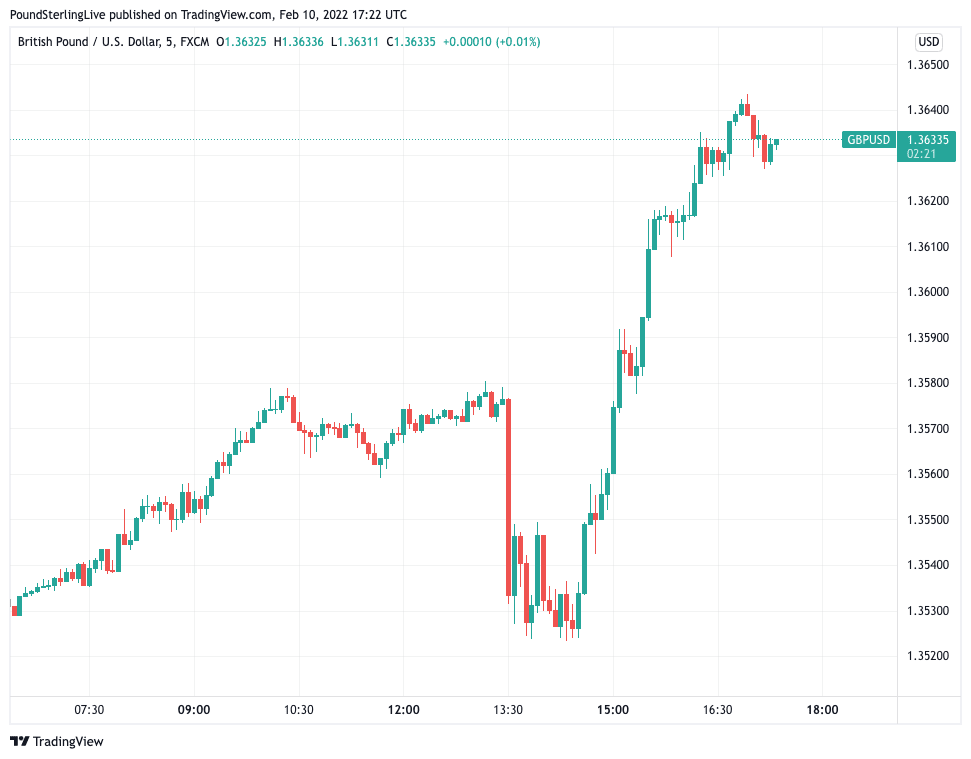Pound / Dollar Makes Strong Gains Following U.S. Inflation Data Release
- Written by: Gary Howes
-
- Another hot U.S. inflation reading
- USD bid higher
- As markets bet on numerous Fed hikes
- But beware a dovish turn at the Fed later

Image © Adobe Images
The Pound to Dollar exchange rate recorded gains of three-quarters of a percent to go back above 1.36 in the wake of another hot U.S. inflation reading.
The Dollar initially rallied as inflation beat market expectations, an apparently textbook reaction that might have been heavily influenced by algorithmic orders.
But as traders digested the data and its wider repercussions for Fed policy selling soon ensued.
Official figures showed U.S. CPI inflation read at 7.5% year-on-year in January, beating the market's expectation for 7.3% and marking a sizeable increase on December's 7.0%.
The month-on-month comparison was stable at 0.6%, up a touch on the market's consensus expectation for 0.5%.
The core CPI reading came in at 6.0% year-on-yearn, which is a sizeable increase on December's 5.5% print, but not massively above what the market was looking for at 5.9%.
"Make no mistake, the Fed will stop at nothing to tighten policy in the near term," says Johan Lof, Senior Economist at Handelsbanken.
The U.S. Bureau for Labor Statistics said increases in the indexes for food, electricity, and shelter were the largest contributors to the seasonally adjusted all items increase
The food index rose 0.9% in January following a 0.5% increase in December and the energy index also increased 0.9% over the month.
"Despite hopes that inflation may be starting to reach its peak in the US, the latest CPI reading has indicated it might be a few months before we can begin contemplating that thought. Markets have been caught unawares by this surprise to the upside and will just reiterate the Federal Reserve’s need to start hiking policy rates at its next meeting," says Hinesh Patel, portfolio manager at Quilter Investors.
With the data baking in expectations for a number of Federal Reserve hikes, why did the Dollar ultimately fall following the data?
The market is anticipating five Fed rate hikes in 2022, for the Dollar to go higher the market would need to push these expectations further.
In short, expectations surrounding the inflation report were not beaten by enough of a margin to really shift the dial on Fed expectations.
This appears to have created a capitulation by Dollar bulls. "Unsurprisingly the stronger than expected January US inflation print at 3.5% sparked a sizeable initial market reaction.
Yields bumped higher, the money market priced in even more Fed rate hikes and EUR/USD slumped lower. The USD, however, was unable to hold the gains resulting in a quick break the other way," says Jane Foley, Senior FX Strategist at Rabobank.
- GBP/USD reference rates at publication:
Spot: 1.3633 - High street bank rates (indicative band): 1.3256-1.3350
- Payment specialist rates (indicative band): 1.3510-1.3565
- Find out about specialist rates and service, here
- Set up an exchange rate alert, here
Looking further ahead, Handelsbanken's Lof says a dovish turn from the Fed awaits in 2022 as it will ultimately become apparent that inflation is set to fade.
"What happens if inflation starts to fade and the Fed sees proof that the inflation risk was overstated? We argue that the Fed would change its course once again, applying a more measured monetary policy tightening. This dovish turn is our main scenario," says Lof.
While the Fed is of course interested in controlling headline CPI inflation, it is arguably more interested in the Employment Cost Index, often referred to as the Fed's favourite metric.
Rising wages are inflationary and are considered confirmation that inflationary pressures have jumped from external drivers to domestic drivers.
The Employment Cost Index actually eased in the fourth quarter of 2021, while the January non-farm payroll report showed an increase in the participation rate. This suggests labour supply is increasing somewhat.
Households’ medium-term inflation expectations meanwhile appear past their peak, even if the long-term expectations have picked up.
The Fed’s own broad index is up, but only marginally.
Handelsbanken also funds that without yet raising the federal funds rate, but by merely changing its forward guidance, the Fed has seen short rates surge and broader financial conditions turn less accommodative.
"If the Fed also found proof that the main inflation risks have been overstated: We argue that the Fed would change its course once again – call it a dovish turn if you will," says Lof.
Handelsbanken forecast three hikes in 2022, while starting quantitative tightening.
"Beyond that, we expect that the Fed will start applying a more measured monetary policy tightening. Three additional hikes Q1 2023 to Q1 2024, while QT continues," says Lof.
Should the Fed pivot in a more 'dovish' direction in response to easing inflation later in the year the Dollar could also make a more sustained turn.
This could allow for more meaningful upside in the Pound to Dollar exchange rate into year-end.











